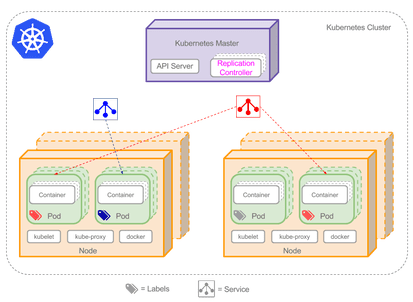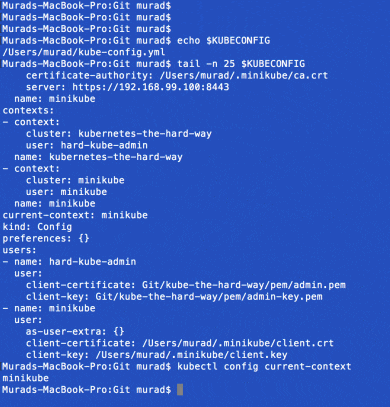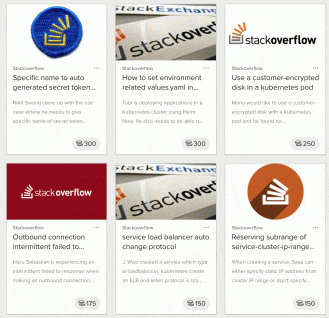Kubernetes is nearly the true stage for holder arrangement. There are some incredible options yet they are second to Kubernetes as far as open-source energy, seller bolstered contributions and extensibility/customization. A developing number of organizations are receiving Kubernetes too with the end goal to institutionalize programming conveyance and run their applications all the more effective. In the event that you are not frequently interfacing with the stage however or you are not included with the venture in some other way, at that point you may, in any case, be letting yourself know, "I have to take in some Kubernetes." Allow me to introduce a system for doing as such.
Essential Concepts
With Kubernetes (frequently curtailed to "Kube" or "K8s"), you should fold your head over some essential ideas first. A Google inquiry will assist you with anything explicit you have to know, yet right off the bat in my Kube venture I invested a ton of energy in the Concepts segment at kubernetes.io. Documentation is a vital piece of the Kubernetes venture so I urge you to devour what's being produced. You ought to eventually be open to portraying key Kubernetes asset objects like Pods, Deployments, and Services. You should start to see the significance and intensity of Labels and Selectors. You ought to likewise obtain an essential feeling of the Kubernetes engineering. I really invested huge energy examining docs on kubernetes.io (the authority Kubernetes site) before endeavoring anything hands-on. I would prescribe taking a gander at different locales as well and perusing their introductions of the ideas. CoreOS has an incredible presentation, for instance.

kubectl (articulated kube-c-t-l)
Everybody's first Kubernetes bunch will in general be Minikube, which is anything but difficult to download and introduce in the event that you might want a K8s play area. You likewise need to introduce kubectl, the friendliest interface for Kubernetes APIs. The setup for kubectl is put away in a KUBECONFIG document which may hold data for various settings, which are client and group sets for the equivalent or diverse bunches. Likewise, don't hesitate to articulate "kubectl" anyway you need.

With kubectl and Minikube introduced, type minikube begin. At the point when start-up is done, kubectl will be designed to point to the Minikube group. On the off chance that utilizing an alternate group, you ought to have the KUBECONFIG close by some place. Attempt a few directions and make sure to assess the yield. I observe kubectl to be quite natural and there are huge amounts of traps/alternate ways or default practices that are enjoyable to find:
cat $KUBECONFIG
kubectl config view
kubectl cluster-info
kubectl get nodes
kubectl get nodes -o wide
kubectl get all
kubectl get pods
kubectl get pods --all-namespaces
kubectl get all --all-namespaces
Investigate the Cheat Sheet in the Reference segment of kubernetes.io. Additionally, this is to some degree progressed yet another extraordinary post from CoreOS on kubectl.
Your First Application(s)
Kubernetes is less intriguing when it isn't running any of your applications. Back on kubernetes.io, visit the Tutorials segment. Begin with Kubernetes 101 at that point proceed onward to "Running a Stateless Application Using a Deployment." Around this time, you should start to feel sure with the ideas and what you are doing. On the off chance that not, venture back and survey the ideas once more, attempt some other essential instructional exercises you find.
Sooner or later, proceed onward to something more perplexing and something closer to home. This implies creating YAML, as a rule by beginning with something that works at that point changing holder pictures, ports, names, constancy, and so on. I constantly discovered running a Jenkins server on Minikube to be a straightforward and fun venture. AcmeAir is another application I explored different avenues regarding from the get-go. You can discover my asset definitions for AcmeAir here.
Steerage is the official bundle director for Kubernetes. Read about Helm, set it up with Minikube, at that point visit the Kubeapps Hub and work with a portion of the diagrams they have facilitated there.
At whatever point you present a demand by means of kubectl to the Kubernetes API server and effectively make assets, make sure to run kubectl again to check the outcome. Utilize the watch utility to see Pods prepare made and enter the state soon after asking for them. A fun trial is to run watch in one terminal and execute cases in another terminal (kubectl erase po ), then observer the case respawn. Note the unit will just respawn if part of a ReplicaSet, which Deployment objects oversee for you, and if kube-scheduler is sound in your group.
Proceeding with Education##
"Kubernetes the Hard Way" by Kelsey Hightower
Kelsey is one of the dopest advocates for Kubernetes. His work incorporates this instructional exercise, a staple in K8s self-training. This instructional exercise takes some time and you ought to do this on Google Cloud, AWS, OpenStack, or some other cloud supplier. On the off chance that you appreciate framework work, you will appreciate this instructional exercise. Hope to take in a ton including insights about TLS design, how to utilize systemd, and the different Kubernetes forms on both hub types. Kelsey makes refreshes pretty consistently so you may learn significantly more than that!
Check out the Community
A tight network of architects and clients drive the Kubernetes venture. The Cloud Native Computing Foundation (CNCF) is the administering body for Kubernetes and numerous other open-source ventures. Kube is viewed as the seed undertaking of CNCF truth be told yet the CNCF scene has spread in only two years. All significant cloud suppliers presently offer Kubernetes as an oversaw administration. There are different players in the network (organizations and people) worth after, also.
Here's a rundown of things you can do to remain connected:
- Buy in to KubeWeekly
- Pursue seller online journals for updates to their separate contributions
- Consistently invest energy taking a gander at various repos, issues, and force asks for on GitHub in the kubernetes association
- Utilize GitHub stars and pursue network individuals on GitHub and Twitter
- Apprenda, CoreOS, Docker, Heptio, Mesosphere, Rancher Labs, and Red Hat are different organizations to pursue. Check the rundown of Partners on kubernetes.io for additional.
- Pursue the action on Slack, Stack Overflow, and Twitter
K8sPort
K8sPort supports KubeWeekly, the pamphlet I referenced already, yet the site additionally gives rewards for sharing Kubernetes reports on Twitter, reacting to issues on Stack Overflow, and other basic exercises. K8sPort is another extraordinary method to check out the network, yet additionally provoke yourself by taking a gander at the Stack Overflow things and endeavoring to react.

Accomplish Mastery##
Turn into a Community Member
There are such a significant number of approaches to add to the Kubernetes venture and turn into a part. Since you are genuinely experienced, you should search for approaches to give back. For instance, creating or enhancing documentation, planning talks, helping individual clients, and settling GitHub issues/PRs are altogether great approaches to contribute, however there are different alternatives as well. Get associated with exchanges if nothing else, join or begin a nearby meetup, and regard different Kubernetes devotees as kin in arms.
Kubernetes Certified Administrator Exam
This exam is genuinely new yet I have effectively caught wind of it being adequately troublesome and fun, with a considerable measure of hands-on investigating over various groups. CNCF has the educational modules for the exam. They likewise offer a course which is explicitly structured as readiness for the affirmation, and you can buy both at a limited cost. This incorporates a free retake of the exam inside a year!
Convey Kubernetes to Your Organization
Without a doubt, the most ideal approach to up your amusement with K8s is to convey it home to your association and run a few applications on the stage. There is a great deal to consider in this, first is your association's current dimension of involvement with application holders. A stage like Kubernetes requires change on various dimensions, in any event in the event that you are hoping to institutionalize over the organization. Not exclusively will you ace Kubernetes from a specialized point of view by endeavoring to drive appropriation, however you will uncover different issues in your organization or programming that will be a test to determine.
I shared a framework of how to learn Kubernetes dependent on my own way and yearnings. There is a considerable measure of material out there so don't confine yourself to the sources I got out. All the more critically, learn constantly or dare to know everything as Kubernetes is moving quick.
To more and for the best tutorials: Click Here